Panasonic NN-ST557W, NN-ST557M User Manual
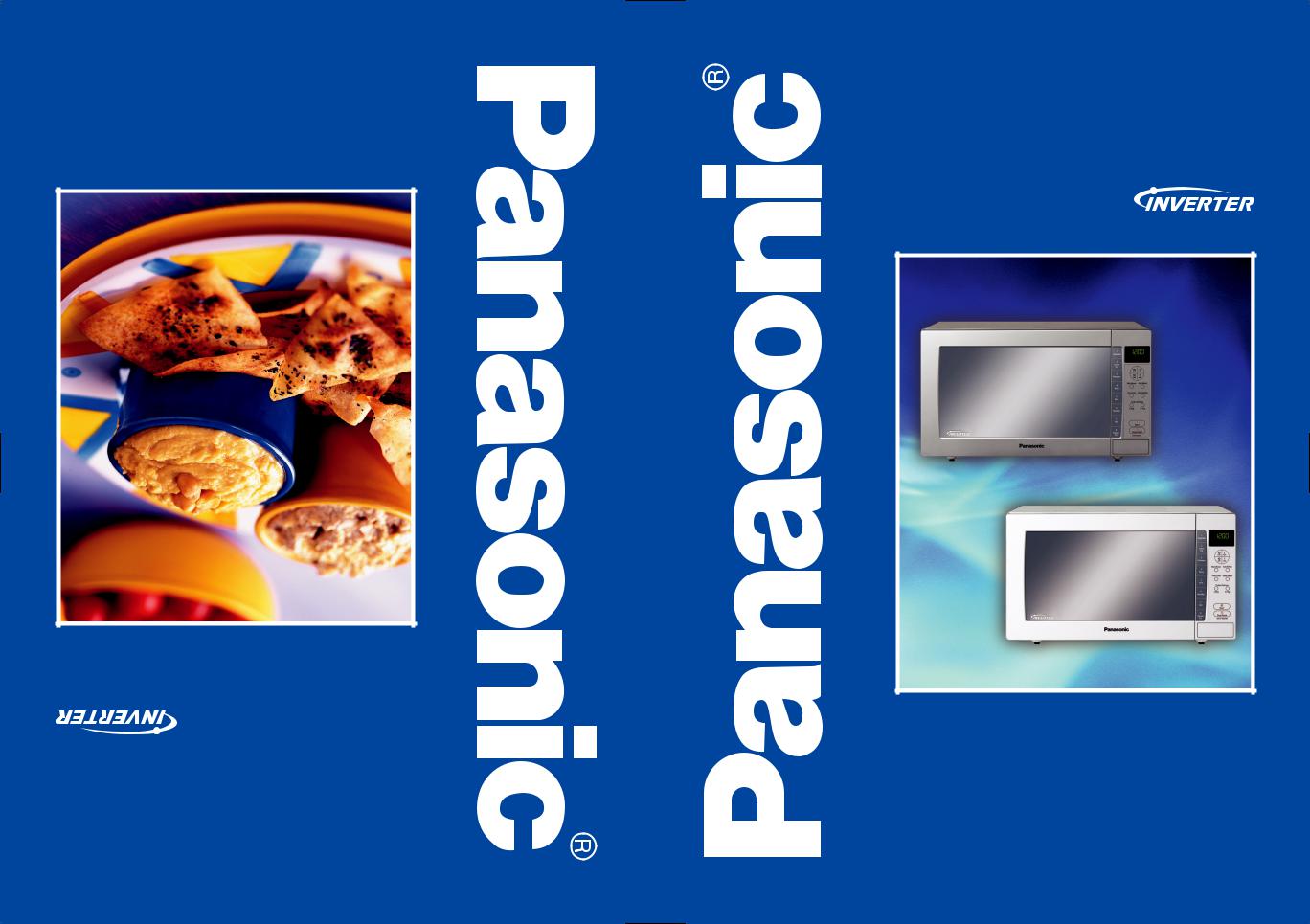
MicrowaveOven
Cookbook
Operation Guide
Microwave Oven
Model Number: NN-ST557M/W

We are glad you have chosen to purchase a PANASONIC microwave oven. Before operating this oven, please read these instructions carefully and completely, and keep them for further reference.
If you have only used a microwave oven for reheating and defrosting, with Panasonic’s Inverter Technology you can be reassured of excellent results when cooking a variety of foods, as the ‘soft’ penetration of microwave energy to the centre of food helps prevent over cooking on edges and surfaces. Foods can now be gently simmered without the concern of boil over.
After reading the introductory chapter, I am sure you will be able to master the basic techniques and thereby develop a firm understanding of your new oven. This book includes recipes from starters to desserts. After trying our recipes be sure to adapt your favourite recipes to microwave methods.
Start experimenting now, and enjoy the first class results you will achieve by using your new microwave oven.
Consultant Home Economist
Fiona Campbell
Panasonic Australia Pty. Ltd.
P.O. Box 505
Frenchs Forest NSW 1640
PANASONIC NZ LTD
CUSTOMER CARE CENTRE
350 Te Irirangi Drive
East Tamaki, Auckland
Private Bag 14911
Panmure, Auckland
Phone: (09) 272-0178
Fax: (09) 272-0137
PANASONIC CONSUMER
COMPANY
Unit 10, Growthpoint Business
Park, Tonnetti Street, Halfway
House, Midrand 1686
P.O Box 1711, Halfway
House, 1685, South Africa
Customer Support Centre: |
086 11 77 777 |
Fax: |
(011) 313-1706 |
The serial number of this product may be found on the |
MODEL NUMBER _______________________ |
back side of the oven. You should note the model |
|
number and serial number of this oven in the space |
SERIAL NUMBER _______________________ |
provided and retain this book as a permanent record |
|
of your purchase for future reference. |
DATE OF PURCHASE ____________________ |
© Copyrighted by Matsushita Electric Industrial Co., Ltd. 2007.
F00038B60QP iPress0707-0 Printed in China

|
Table of Contents |
|
Before Operation |
|
|
Safety Instructions....................................................................................................................................... |
1 |
|
Installation and General Instructions........................................................................................................... |
2 |
|
Microwaves and How They Work................................................................................................................ |
3 |
|
Cookware and Utensisl Guide ................................................................................................................. |
3-4 |
|
Feature Diagram ......................................................................................................................................... |
5 |
|
Control Panel |
.............................................................................................................................................. |
6 |
Ingredient Conversion .....................................................................................................................Chart |
12 |
|
Operation and Hints |
|
|
Let's Start to Use ......................................................................................................................Your Oven |
7 |
|
Operation Guide .....................................................................................................in the Display Window |
7 |
|
To Set Clock................................................................................................................................................ |
|
8 |
To Use Child ............................................................................................................................Safety Lock |
8 |
|
To Use Timer .....................................................................................................................................Pad |
14 |
|
To Cook .......................................................................................... |
by MICRO POWER AND TIME |
9 |
................................................................................................... |
using AUTO COOK Pad |
13 |
To Reheat .......................................................................................... |
by MICRO POWER AND TIME |
9 |
............................................................................................... |
using AUTO REHEAT Pad |
12 |
To Defrost .......................................................................................... |
by MICRO POWER AND TIME |
9 |
.................................................................................... |
using TURBO DEFROST Pad |
10-11 |
Quick Guide to ..........................................................................................................................Operation |
18 |
|
Maintenance |
|
|
Before Requesting .......................................................................................................................Service |
15 |
|
Care of Your Oven .................................................................................................................................... |
16 |
|
Technical Specifications............................................................................................................................ |
16 |
|
Panasonic Warranty.................................................................................................................................. |
17 |
|
|
|
Turn over for Cookbook |

Safety Instructions
Precautions to be taken when using Microwave Ovens for Heating foodstuffs
INSPECTION FOR DAMAGE. A microwave oven should only be used if an inspection confirms all of the following conditions:
1.The door fits squarely and securely and opens and closes smoothly.
2.The door hinges are in good condition.
3.The metal plates of a metal seal on the door are neither buckled nor deformed.
4.The door seals are neither covered with food nor
have large burn marks. PRECAUTIONS. Microwave radiation from
microwave ovens can cause harmful effects if the following precautions are not taken:
1.Never tamper with or deactivate the interlocking devices on the door.
2.Never poke an object, particularly a metal object, through a grille or between the door and the oven while the oven is operating.
3.Never place saucepans, unopened cans or other heavy metal objects in the oven.
4.Do not let other metallic articles, e.g., fast food foil containers, touch the side of the oven.
5.Clean the oven cavity, the door and the seals with water and a mild detergent at regular intervals. Never use any form of abrasive cleaner that may scratch or scour surfaces around the door.
6.Always use the oven with trays or cookware recommended by the manufacturer.
7.Never operate the oven without a load (i.e., an absorbing material such as food or water) in the oven cavity unless specifically allowed in the manufacturer’s literature.
8.For horizontally hinged doors, never rest heavy objects such as food containers on the door while it is open.
9.Do not place sealed containers in microwave ovens. Baby bottles fitted with a screw cap or a teat are considered to be sealed containers.
10.The appliance is not intended for use by young children or infirm persons without supervision.
11.Young children should be supervised to ensure that
they do not play with the appliance.
Important Instructions
WARNING—To reduce the risk of burns, electric shock, fire, injury to persons or excessive microwave energy:
1.Read all instructions before using the microwave oven.
2.Some products such as whole eggs and sealed containers - (for example, closed glass jars and sealed baby bottles with teat) - may explode and should not be heated in the microwave oven.
3.Use this microwave oven only for its intended use as described in this manual.
4.As with any appliance, close supervision is necessary when used by children.
5.Do not operate this microwave oven if it is not working properly or if it has been damaged or dropped.
6.To reduce the risk of fire in the oven cavity:
(a)Do not overcook food. Carefully attend microwave oven if paper, plastic, or other combustible materials are placed inside the oven to facilitate cooking.
(b)Remove wire twist-ties from bags before placing bag in oven.
(c)If materials inside the oven should ignite, keep oven door closed, turn oven off at the wall switch, or shut off power at the fuse or circuit breaker
panel.
Earthing Instructions
This microwave oven must be earthed. In the event of an electrical short circuit, earthing reduces the risk of electric shock by providing an escape wire for the electric current. This microwave oven is equipped with a cord having an earthing wire with an earthing plug. The plug must be plugged into an outlet that is properly installed and earthed.
WARNING—Improper use of the earthing plug can result in a risk of electric shock.
WE CERTIFY THAT THIS MICROWAVE OVEN HAS BEEN INSPECTED AND COMPLIES WITH THE REQUIREMENTS OF REGULATION 3, SUBCLAUSE(2), OF THE MICROWAVE OVENS REGULATIONS 1982.
MATSUSHITA ELECTRIC INDUSTRIAL CO.,LTD.
(This statement applicable only to New Zealand.)
We certify that this microwave oven has been inspected and complies with the safety requirements of government notice 466 of March 1981, and complies with the Radio Regulation of government notice 587 of March 1986.
(This statement applicable only to South Africa)
WARNING
a)The door seals and door seal areas should be cleaned with a damp cloth. The appliance should be inspected for damage to the door seals and door seal areas and if these areas are damaged the appliance should not be operated until it has been repaired by a qualified service technician trained by the manufacturer.
b)It is dangerous for anyone other than a qualified service technician trained by the manufacturer to perform repair services.
c)If the supply cord of this appliance is damaged, it must be replaced by a qualified service technician with the special cord available only from the manufacturer.
d)Before use, the user should check that utensils are suitable for use in microwave ovens.
e)Liquids or other foods must not be heated in sealed containers since they are liable to explode.
f)Only allow children to use the oven without supervision when adequate instructions have been given so that the child is able to use the oven in a safe way and understands the hazards of improper use.
– 1 –

Installation and General Instructions
General Use
1.In order to maintain high quality, do not operate the oven when empty. The microwave energy will reflect continuously throughout the oven if no food or water is present to absorb energy.
2.If smoke is observed, press the STOP/RESET Pad and leave door closed in order to stifle any flames. Disconnect the power cord, and/or shut off power at the fuse or circuit breaker panel.
3.Do not dry clothes, newspapers or other materials in oven. They may catch on fire.
4.Do not use recycled paper products, unless the paper product is labelled as safe for microwave oven use. Recycled paper products may contain impurities which may cause sparks and/or fires when used.
5.Do not use newspapers or paper bags for cooking.
6.Do not hit or strike the Control Panel. Damage to controls may occur.
7.POT HOLDERS may be needed as heat from food is transferred to the cooking container and from the container to the Glass Tray. The GlassTray can be very hot after removing the cooking container from the oven.
8.Do not store flammable materials next to, on top of, or in the oven. It could be a fire hazard.
9.Do not cook food directly on Glass Tray unless indicated in recipes. (Food should be placed in a suitable cooking utensil.)
10.DO NOT use this oven to heat chemicals or other non-food products. DO NOT clean this oven with any product that is labelled as containing corrosive chemicals. The heating of corrosive chemicals in this oven may cause microwave radiation leaks.
11.Look at the oven from time to time when food is heated or cooked in disposal containers of plastic, paper or other combustible materials, as these types of containers ignite if overheated.
Placement of Oven
1.The oven must be placed on a flat, stable surface. For correct operation, the oven must have sufficient air flow. Allow 15 cm of space on the top of the oven, 10 cm at the back, and 5 cm on both sides. If one side of the oven is placed flush to wall, the left side or top must not be blocked. Do not remove feet.
a.Do not block air vents. If they are blocked during operation, the oven may be overheated and damaged. When using any cloth over the oven, the air intake and exhaust should not be blocked. Also allow sufficient space on back and both sides of the oven.
b.Do not place oven near a hot or damp surface such as a gas stove, electric range or sink etc.
c.Do not operate oven when room humidity is too high.
2.This oven was manufactured for household use only.
3.This microwave oven is designed and approved for counter top use only. Failure due to built-in installation may void the warranty.
Circuits
Your microwave oven should be operated on a separate 10 A circuit from other appliances. Failure to do this may cause the power board fuse to blow, and/or food to cook slower. Do not insert higher value fuse in the power board.
Food
1.Do not use your oven for home canning or the heating of any closed jar. Pressure will build up and the jar may explode. In addition, the microwave oven cannot maintain the food at the correct canning temperature. Improperly canned food may spoil and be dangerous to consume.
2.Do not attempt to deep fat fry in your microwave oven.
3.Do not boil eggs in their shell and whole hard-boiled eggs (unless otherwise stated in Cooking Guide section). Pressure will build up and the eggs will explode.
4.Potatoes, apples, egg yolks, whole squash and sausages are examples of foods with nonporous skins. This type of food must be pierced before cooking, to prevent bursting.
5.When heating liquids, e.g. soup, sauces and beverages, in your microwave oven, overheating the liquid beyond boiling point can occur without evidence of bubbling. This could result in a sudden boil over of hot liquid. To prevent this possibility the following steps should be taken:
a)Avoid using straight-sided containers with narrow necks.
b)Do not overheat.
c)Stir the liquid before placing the container in the oven and halfway through cooking time.
d)After heating, allow to stand in the oven for a short time, stirring again before carefully removing the container.
6.DO NOT USE A CONVENTIONAL MEAT THERMOMETER IN THE MICROWAVE OVEN. To check the degree of cooking of roasts and poultry use a MICROWAVE THERMOMETER.
Alternatively, a conventional meat thermometer may be used after the food is removed from the oven. If undercooked, return meat or poultry to the oven and cook for a few more minutes at the recommended power level. It is important to ensure that meat and poultry are thoroughly cooked.
7.COOKING TIMES given in the Cooking Guide section are APPROXIMATE. Factors that may affect cooking time are preferred degree of moisture content, starting temperature, altitude, volume, size, shape of food and utensils used. As you become familiar with the oven, you will be able to adjust for these factors.
8.It is better to UNDERCOOK RATHER THAN OVERCOOK foods. If food is undercooked, it can always be returned to the oven for further cooking. If food is overcooked, nothing can be done. Always start with minimum cooking times recommended.
9.Extreme care should be taken when cooking popcorn in a microwave oven. Cook for minimum time as recommended by manufacturer. Use the directions suitable for the wattage of your microwave oven. NEVER leave oven unattended when popping popcorn.
10.When heating food in plastic or paper containers, check the oven frequently due to the possibility of ignition.
11.The contents of feeding bottles and baby food jars are to be stirred or shaken and the temperature is to be checked before consumption, in order to avoid burns.
– 2 –

Microwaves and How They Work
Microwaves are a form of high frequency radio waves similar to those used by a radio, including AM, FM and CB. They are similar to a television where the radio waves are converted to a picture on the screen. However, microwaves are much shorter than radio waves; approximately twelve centimetres wave length. Electricity is converted into microwave energy by the magnetron tube (which is the heart of the microwave oven).
From the magnetron tube, microwave energy is transmitted to the oven cavity through a small plastic covered piece. The microwaves are converted to heat in the food. The microwaves enter from the outside of the food and travel through the food losing half of their power every two to three centimetres. Continued cooking to the centre occurs by conduction.
Although pacemakers used to be affected by microwaves (as well as by other radio waves), they are now shielded and are not bothered by these interferences. This allows people with pacemakers to sit calmly by their radio or television and cook with microwave ovens.
When microwaves come in contact with a substance, any one or combination of three things may occur. They can be:
1.REFLECTED
2.TRANSMITTED
3.ABSORBED
Reflection:
Metal substances REFLECT microwave energy and because there is no absorption, there is no heating. This is why the oven interior is either stainless steel or epoxy-coated steel. This ensures that the microwaves are kept inside the cavity and evenly distributed throughout the food with the help of the turntable.
Transmission:
Such substances as paper, glass and plastic TRANSMIT microwave energy and do not become hot except from food. Because these substances do not reflect or absorb microwave energy, they are ideal materials for microwave cooking containers.
Absorption:
Food contains moisture and will ABSORB microwave energy, which causes the moisture molecules within the food to vibrate at an incredible rate (2,450,000,000 times per second). Friction, created by the vibration, produces heat energy which is conducted throughout the food.
Cookware and Utensils Guide
It is important to use the correct container when cooking in a microwave oven. The following will help you make the right selection.
How to Test a Container for Safe Microwave Oven Use
TO TEST A CONTAINER FOR SAFE MICROWAVE OVEN USE: Fill a 1-cup glass measure with cool water and place it in the microwave oven alongside the empty container to be tested; heat one (1) minute at HIGH. If the container is microwave ovensafe (transparent to microwave energy), the container should remain comfortably cool, the water in glass measure should be hot. If the container is hot, it has absorbed some microwave energy and should NOT be used. This test cannot be used for plastic containers.
Paper Products and Freezer Wrap
Waxed paper, paper plates, cups and napkins should not be used for heating or cooking food. Freezer wrap should not be used as it is not heat resistant and may melt. Paper towel, greaseproof paper and bake paper may be safely used for short periods of time for covering or lining.
Glass, Ceramic and China
Heat-Resistant glass cookware is invaluable in microwave cooking. Many of these items are readily available in most homes: glass jugs, mixing bowls, loaf dishes, covered casseroles, oblong baking dishes, pie plates and round or square cake dishes. Examples of this type of cookware are Pyrex® and Corningware®.
Dinnerware can be used for microwave heating. Many brands of dinnerware are microwave safe. Check the care information for reference to microwave use for dinnerware and serving pieces. If dinnerware is marked ovenproof, it frequently is safe to use in the microwave oven. However, to be sure, check by conducting microwave dish test previously mentioned.
Several types of glassware and dinnerware are not recommended for use in the microwave oven. Do not use dishes with metallic trim or containers with metal parts. Do not use cups or mugs with glued on handles, as they may fall off with continued heating. Do not use delicate glassware. Although the glassware may be transparent to microwave energy the heat from the food may cause the glassware to crack.
– 3 –

Cookware and Utensil Guide (continued)
Plastics |
Metal |
Plastic dishes, cups and some freezer containers should be used with care in a microwave oven. Choose plastic containers carefully, as some plastic containers may become soft, melt and may scorch. The majority of plastic dishes, even those designed for use in the microwave oven, are not suitable for cooking foods with high fat or sugar content, or for lengthy cooking times. Most microwave plastic dishes should not be used for longer than 3 to 5 minutes on HIGH power. These dishes, although not suitable for extended cooking, may be used successfully for defrosting or for use on lower power levels.
Cooking Bags designed to withstand boiling, freezing, or conventional heating are microwave safe. Prepare bags according to manufacturer’s directions. When cooking by microwave, DO NOT use wire twist-ties to close bag. They can act as an antenna and cause arcing (sparks).
DO NOT COOK IN PLASTIC FOOD STORAGE BAGS.
Plastic Wrap such as GLAD WRAP® can be used to cover dishes in most recipes. Over an extended heating time, some disfiguration of the wrap may occur. When removing plastic wrap “covers”, as well as any glass lid, be careful to remove it away from you to avoid steam burns.
Loosen plastic but let dish stand, covered.
Jars and Bottles
Jars and bottles can be used to warm food to serving temperature, if the lid is removed first. Cooking should not be done in these containers since most are not heat resistant and during extended heating times, heat from food would cause cracking or breaking.
Metal cookware or utensils, or those with metallic trim, should NOT be used in the microwave. Since microwave energy is reflected by metal, foods in metal containers will not cook evenly. There is also a possibility of “arcing.”
Although metal utensils should be avoided in microwave cooking, some metal can be helpful when used correctly.
Aluminum foil can be used safely, if certain guidelines are followed, to prevent overcooking. Small pieces of foil are used to shield areas such as chicken wings, tips of roasts, or other thin parts that cook before the rest of the recipe is finished. Make sure foil is attached securely and doesn’t touch sides of oven, otherwise arcing may occur. Foil lined containers, either cardboard or plastic, should NOT be used in the microwave oven as arcing could occur.
Metal twist-ties, either paper or plastic coated, should NOT be used in the microwave oven. Frozen dinner trays can be used in the microwave, if the container is no deeper than 2 cm and is filled with food. Metal skewers can not be used in microwave ovens as arcing may occur. Wooden skewers are readily available and give the same result.
Shells: Scalloped baking shells are best used during reheating and for short periods of cooking time only.
Thermometers are available for use in microwave ovens. DO NOT USE CONVENTIONAL MERCURY TYPE CANDY OR MEAT THERMOMETERS in food while cooking in the microwave oven.
Straw, Wicker and Wood
Straw and wicker baskets may be used in the microwave oven for short periods of time to warm rolls or bread. Large wooden utensils, such as bowls or cutting boards should NOT be used for prolonged heating as the microwave energy may cause the wood to become dry and brittle.
– 4 –
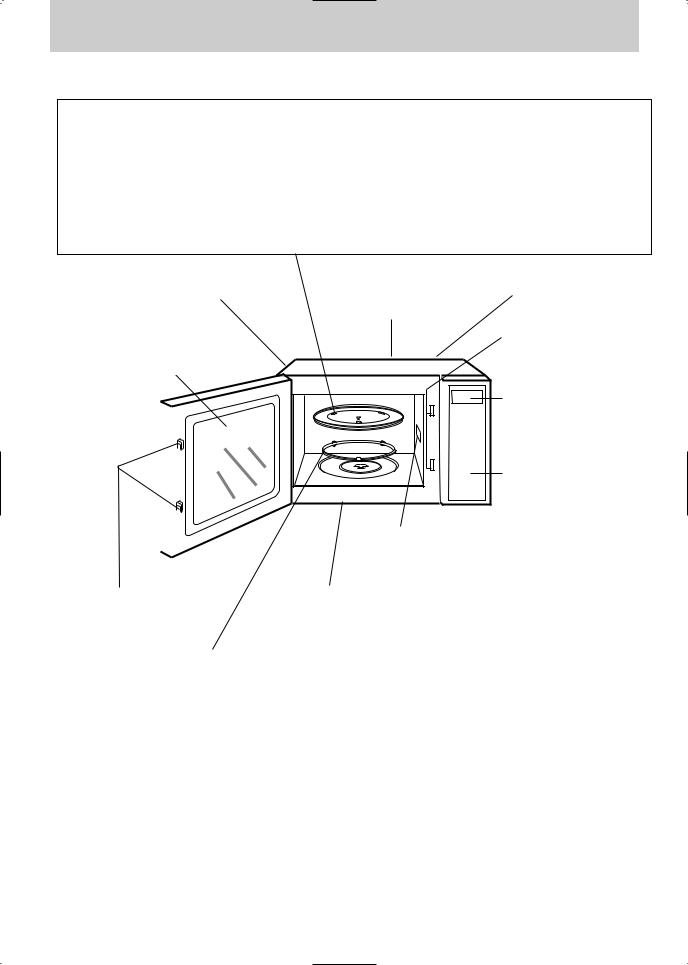
Feature Diagram
Glass Tray
1.Do not operate the oven without the Roller Ring and Glass Tray in place.
2.Only use the Glass Tray specifically designed for this oven. Do not substitute another Glass Tray.
3.If Glass Tray is hot, allow to cool before cleaning or placing in water.
4.Do not cook directly on Glass Tray. Always place food on a microwave-safe dish, or on a rack set in a microwave-safe dish.
5.If food or utensil on Glass Tray touches oven walls, causing the tray to stop moving, the tray will automatically rotate in opposite direction. This is normal.
6.Glass Tray can rotate in either direction.
Exhaust Air Vents |
Identification Plate |
Inlet Air Vents |
The model number and serial |
|
|
|
number are displayed here |
|
Oven Window with Vapour Barrier Film
(do not remove)
Door Safety
Lock System
Waveguide Cover (do not remove)
External Air Vents
Door Safety
Lock System
Display
Window
Control Panel
•Covered with removable protective film to prevent scratches during shipping. Small bubbles may appear under this film. When this happens, remove film carefully.
(Hint - apply masking or clear tape to an exposed corner and pull gently to remove.)
Roller Ring
1.The Roller Ring and oven floor should be cleaned frequently to prevent excessive noise and scratching of painted surface.
2.The Roller Ring must always be used together with the Glass Tray for cooking.
Door Release Button
Push to open the door. Opening the door during cooking will stop the cooking process without cancelling the program. Cooking resumes as soon as the door is closed and Start Pad is pressed. It is quite safe to open the door at any time during a cooking program and there is no risk of Microwave exposure.
Oven Light
Oven Light will turn on during cooking and also when door is opened.
– 5 –
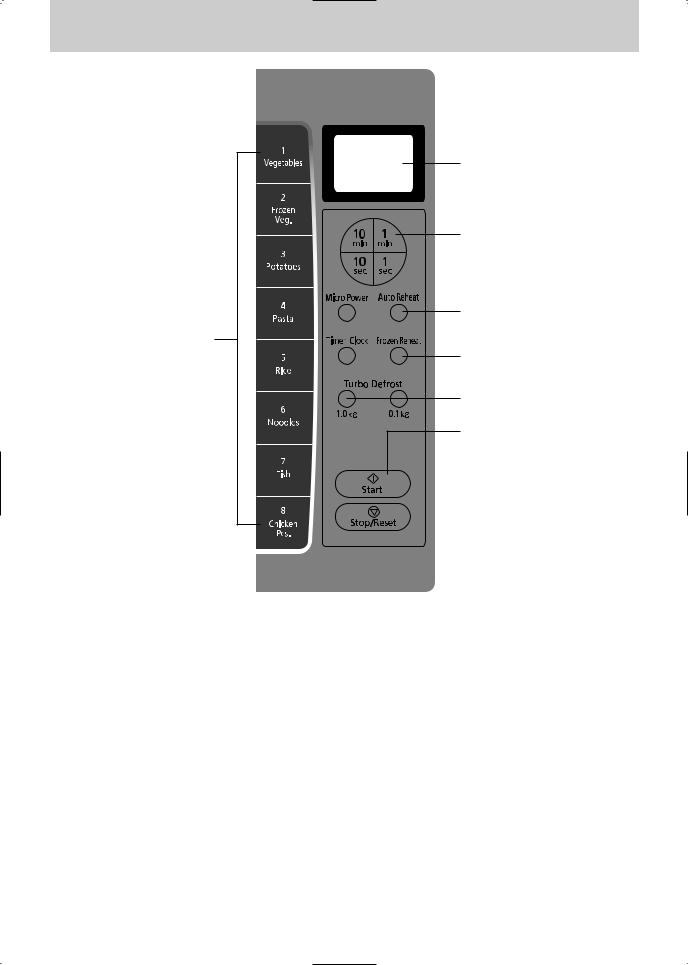
Control Panel
Display Window
Time Pads
Auto Reheat Pad (pg. 12)
 Micro Power Pad (pg. 9)
Micro Power Pad (pg. 9)
Auto Cook Pads (pg. 13)
Frozen Reheat Pad (pg. 12)
 Timer/Clock Pad (pg. 14)
Timer/Clock Pad (pg. 14)
Turbo Defrost Pad (pg. 10)
Start Pad
One tap allows oven to begin functioning. If door is opened or
Stop/Reset Pad is pressed once
during oven operation, Start Pad must again be pressed to restart
oven.





 Stop/Reset Pad
Stop/Reset Pad
Before cooking: One tap clears your instructions.
During cooking: One tap temporarily stops the cooking process. Another tap cancels all your instructions and time of day appears in the Display Window.
Beep Sound
When a pad is pressed correctly, a beep sound will be heard. If a pad is pressed and no beep is heard, the unit did not or could not accept the instruction. The oven will beep twice betwen programmed stages. At the end of any completed program, the oven will beep 5 times.
Note:
If an operation is set and Start Pad is not pressed, after 6 minutes, the oven will automatically cancel the operation. The display will revert back to clock or colon mode.
– 6 –
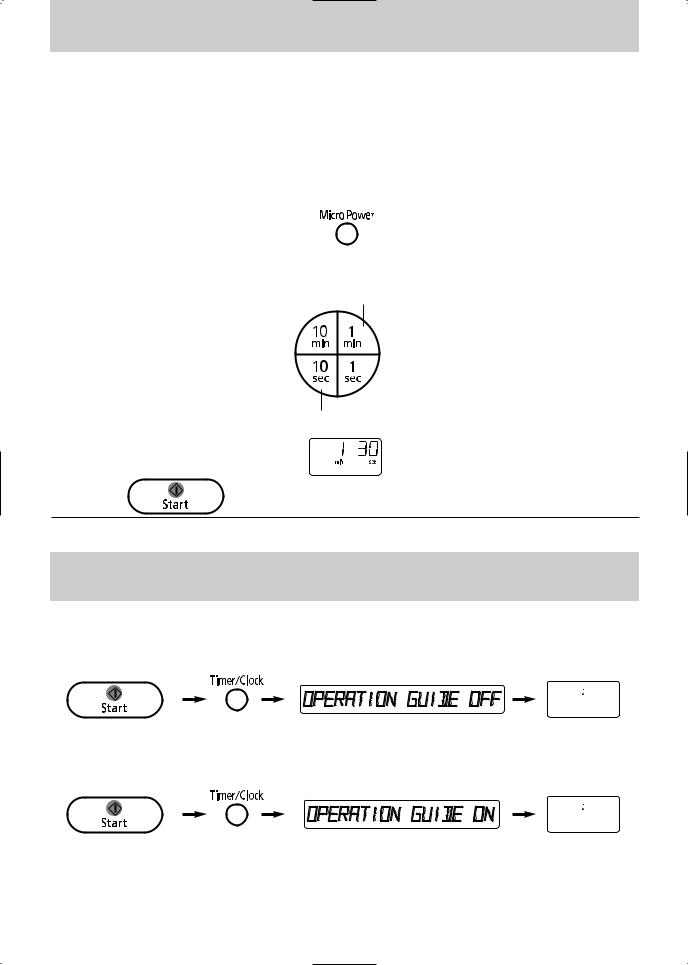
Let’s Start To Use Your Oven!
1 |
Plug in |
|
||
|
Plug into a properly earthed electrical outlet. “WELCOME TO PANASONIC MICROWAVE OVEN |
|||
|
COOKING” appears in the Display Window. (This will immediately cease when any pad is pressed.) |
|||
2 |
Open Door |
|
||
|
Open the door and place container with food on Glass Tray in the oven. Then close the door. |
|||
3 |
Select Power Level |
|
||
|
e.g. Med-High |
|
||
|
Press Micro Power Pad three times. |
|
||
|
|
|
|
|
|
(see page 9 for Micro Power chart) |
|
||
4 |
Set Time |
|
||
|
e.g. 1 minute 30 seconds |
once |
||
|
|
|
|
|
Press numbered Time Pads
3 times
Verify your selection(s) in the Display Window.
5 Press
Operation Guide in the Display Window
To assist you in programming your oven, the following operation will appear in the Display Window. When you become familiar with your oven, the Operation Guide can be turned off.
To turn off:
Press 2 seconds. |
Press 3 times. |
Display Window |
Colon or time of day |
|
|
|
appears in the |
|
|
|
Display Window. |
To turn on: |
|
|
|
Press 2 seconds. |
Press 3 times. |
Display Window |
Colon or time of day |
|
|
|
appears in the |
|
|
|
Display Window. |
– 7 –

To Set Clock
You can use the oven without setting the clock.
1 Press |
twice. |
Colon will blink in Display Window.
2 Enter Time of Day
Enter time of day using Time Pads e.g. 12:35
Clock is a 12 hour display. There isn’t a.m. or p.m. setting.
Press once |
twice |
3 times |
5 times |
3 Press
Colon stops blinking; time of day is entered and locked into Display Window.
NOTES: 1. Oven will not operate while colon is still blinking
2.To reset time of day, repeat step 1 through 3.
3.The clock will keep the time of day as long as oven is plugged in and electricity is supplied.
4.Maximum time available is 12:59. Clock is 12 hour only. One o'clock will be displayed as 1:00 not 13:00.
To Use Child Safety Lock
This feature allows you to prevent operation of the oven by a young child; however, the door will open. You can set Child Safety Lock when colon or time of day is displayed.
To set:
Colon or time of |
Press 3 times. |
Display Window |
day is displayed |
|
|
To cancel:
Display Window |
Press 3 times. |
Colon or time of |
|
|
day is displayed |
– 8 –

To Cook / Reheat / Defrost by Micro Power and Time
1 Select Power Level
Press Micro Power Pad until the
power level appears in the Display Window. (see chart below)
Note: When selecting High on the first stage, you can start from step 2.
2 Set Cooking Time
(High power: maximum up to 30 minutes or 29 minutes 99 seconds, other power levels: up to 99 minutes and 99 seconds for a single stage)
5 times
e.g. 5 minutes
3 Press
Cooking will start.
The time in the Display Window will count down.
For more than one stage cooking,
Repeat steps 1 & 2 above then press Start. The maximum number of stages for cooking is 3. The oven will beep twice between stages.
e.g. : Casserole |
Stage 1 |
Stage 2 |
|
High for 10 minutes |
Med-High for 80 minutes |
|
to bring to a boil |
to finish cooking by simmering |
|
|
|
Micro Power:
The Micro Power Pad gives you a selection of different power levels representing decreasing amounts of microwave energy, used for cooking foods at different speeds.
e.g.The lower the micro power setting, the more evenly the food cooks, although it will take a little longer. To select the correct power level for cooking different foods, refer to the chart below.
Press |
POWER LEVEL |
WATTAGE |
EXAMPLE OF USE |
1x |
HIGH |
1100 W |
Boil water. Reheat. Cook vegetables, rice, pasta and noodles. |
2x |
MED-HIGH |
770 W |
Cook poultry, meat, cakes, desserts. Heat milk. |
3x |
MEDIUM |
600 W |
Cook beef, lamb, eggs, fish and seafood. Melt butter. |
4x |
MED-LOW |
330 W |
Simmer soups, stews and casseroles (less tender cuts). |
5x |
DEFROST |
330 W |
Thaw foods. |
6x |
LOW |
110 W |
Keep cooked foods warm, simmer slowly. |
Note:
After using the oven, the fan may rotate to cool the electric components. This is perfectly normal, and you can take out the food from the oven while the fan operates.
– 9 –

To Defrost
Turbo Defrost
This feature allows you to defrost meat, poultry and seafood automatically by just setting the weight of the food.
1 Set Weight
The shape and size of the food will determine the maximum weight the oven can accommodate. The recommended maximum weight of food depends on the oven cavity size. Weight must be programmed in kilograms and tenths of a kilogram (max 3.0 kg).
Enter weight.
2 Press
Defrost time appears in the Display Window and begins to count down.
When cooking time is longer than 60 minutes, the time will appear in hours and minutes.
NOTES:
For further information, refer to next page.
Defrost by Micro Power and Time Setting
Defrosting is done on DEFROST Power
1. |
2. |
3. |
• Press fifth for Defrost. |
• Set time according to chart on page 11. |
• Press. |
– 10 –

Defrosting Tips and Techniques
Preparation for Freezing:
1.Heavy-duty plastic wraps, bags and freezer wrap are suitable.
2.Freeze meats, poultry and fish in packages with only 1 or 2 layers of food. To aid in separating layers, place two pieces of wax paper between them.
3.REMOVE ALL AIR and seal securely.
4.LABEL package with type and cut of meat, date and weight.
5.Defrosting times given in the charts are for thoroughly frozen foods (i.e. at least 24 hours in freezer maintained at -18°C or lower).
Defrosting Technique:
1.Remove from wrapper and set on a defrosting rack in a dish on Glass Tray.
2.On Turbo Defrost, the oven will beep during the defrosting time. At “beep”, turn over all meat, poultry, fish and shellfish. Break apart stewing meat, chicken pieces and minced meat. Separate chops and hamburger patties.Shield thin ends of roasts, poultry legs and wings, fat or bones with foil.
3.Throughout the defrosting time, remove any defrosted portions of mince or cubed meat, etc.
4.After defrosting, large roasts may still be icy in the centre. Let stand, 15 to 30 minutes, in refrigerator to complete defrosting.
Defrosting Chart (by setting Micro Power at Defrost):
FOOD |
APPROX. TIME |
INSTRUCTION |
||
(minutes per 500 g) |
||||
|
|
|||
MEAT |
|
|
|
|
Beef |
|
|
|
|
Minced Beef |
8 |
- 11 |
Halfway through the defrost cycle, break apart minced beef, |
|
Roast: Topside |
12 |
- 15 |
separate chops and remove meat that is defrosted. |
|
Beef Tenderloin |
12 |
- 15 |
|
|
Chuck or Rump |
10 |
- 13 |
Turn meat over two to three times during defrosting. |
|
Sirloin, rolled |
11 |
- 14 |
|
|
Steak |
8 |
- 10 |
Shield edges and unevenly shaped ends of roasts halfway |
|
Miscellaneous |
8 |
- 12 |
through the defrost cycle. |
|
Pork/Lamb |
|
|
|
|
Roast |
9 |
- 12 |
Large roasts may still be icy in centre. Let stand. |
|
Chops |
8 |
- 11 |
|
|
Ribs |
8 |
- 12 |
|
|
|
|
|
|
|
POULTRY |
|
|
Turn poultry over two to four times during defrosting. |
|
Chicken |
|
|
Halfway through the defrost cycle, shield end of drumsticks, |
|
whole |
9 |
- 12 |
wings, breast bones and ends of poultry with foil. |
|
pieces |
8 |
- 11 |
|
|
fillets |
8 |
- 10 |
Break apart chicken pieces and remove small pieces such |
|
Duck |
10 |
- 12 |
as wings, which may be defrosted before larger pieces. |
|
Turkey |
10 |
- 13 |
|
|
|
|
|
Rinse poultry under cold water to remove ice crystals. Let |
|
|
|
|
stand 5 to 10 minutes, before cooking. |
|
|
|
|
|
|
FISH & SHELLFISH |
|
|
|
|
Fish Fillets |
9 |
- 11 |
Halfway through the defrost cycle, turn whole fish or blocks |
|
Whole Fish |
9 |
- 12 |
of fillets over. Also, break apart prawns or scallops. |
|
Crabmeat |
8 |
- 10 |
Remove any pieces that are defrosted. |
|
Lobster Tails |
8 |
- 10 |
|
|
Sea Scallops |
8 |
- 10 |
Let stand, 5 to 10 minutes, before cooking. |
|
Green Prawns |
10 |
- 12 |
|
|
|
|
|
|
|
– 11 –
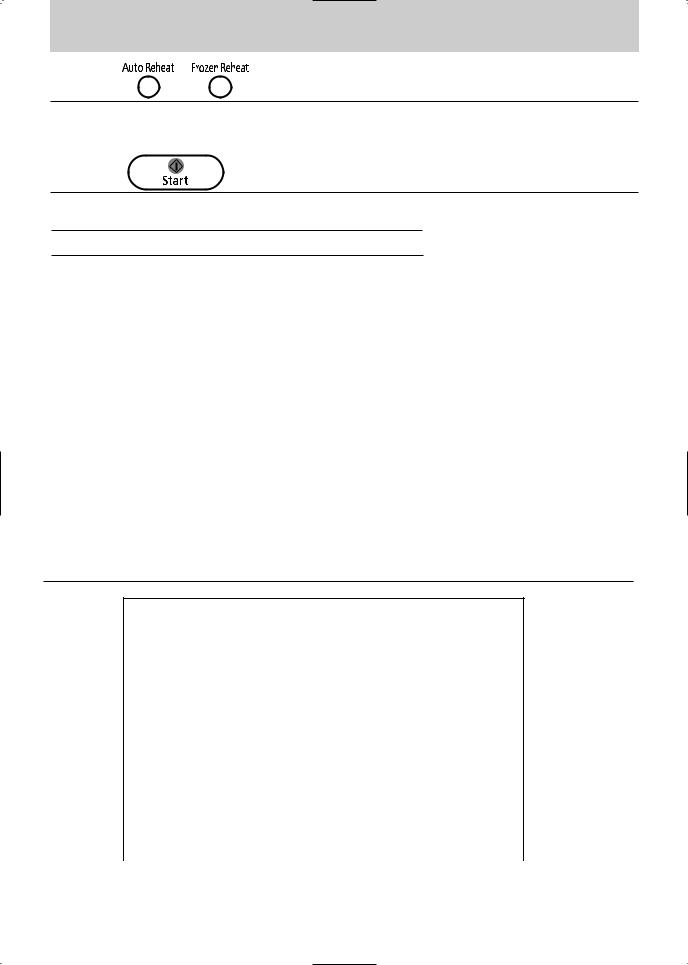
To Reheat Food Using Auto Reheat / Frozen Reheat Pads
1 Press
or
until the desired weight appears in the Display Window.
2 Press
Reheating time appears in the Display Window and begins to count down.
For best results on Auto Reheat, follow these recommendations:
Auto Reheat (250 g - 850 g)
•All foods must be pre-cooked. Suitable for casseroles, plated dinners, soups, stews, pasta dishes (except lasagne), and canned foods.
•Do not reheat bread or pastry products; raw; uncooked or frozen foods; or beverages.
•Foods should be reheated from room temperature or refrigerator temperature. Do not reheat frozen foods on this setting.
•Foods should be covered loosely but completely with plastic wrap or a casserole lid which does not snap seal.
•Foods weighting less than 200 g and more than 900 g should be reheated by Micro Power and Time only.
•All foods should have a covered stand time of 3 to 5 minutes at the end of reheating.
•Halfway through the cooking time, the oven will ‘beep’ to prompt you to stir or rearrange the foods. At the end of the cooking time, stir and let stand for 3 to 5 minutes.
Frozen Reheat (250 g - 850 g)
•Suitable for reheating pre-cooked soups, stews, casseroles, roast dinners, pasta dishes (except lasagne) and rice dishes from frozen temperature.
•This setting is not suitable for reheating frozen bread or pastry products, raw or uncooked foods or beverages.
•Remove convenience foods from foil or plastic packaging and place in an appropriate size dish.
•Cover dish with plastic wrap or a lid which does not snap seal.
•Halfway through the cooking time, the oven will ‘beep’ to prompt you to stir or rearrange the foods. At the end of the cooking time, stir and let stand for 3 to 5 minutes.
INGREDIENT CONVERSION CHART
1⁄4 cup |
60 ml |
1⁄4 teaspoon |
1 ml |
1⁄3 cup |
85 ml |
1⁄2 teaspoon |
2 ml |
1⁄2 cup |
125 ml |
1 teaspoon |
5 ml |
2⁄3 cup |
165 ml |
2 teaspoons |
10 ml |
3⁄4 cup |
190 ml |
3 teaspoons |
15 ml |
1 cup |
250 ml |
1 tablespoon |
20 ml |
11⁄4 cups |
310 ml |
11⁄2 tbs |
30 ml |
11⁄2 cups |
375 ml |
2 tbs |
40 ml |
2 cups |
500 ml |
3 tbs |
60 ml |
3 cups |
750 ml |
4 tablespoons |
80 ml |
31⁄2 cups |
875 ml |
|
|
4 cups |
1 litre |
|
|
6 cups |
1.5 litre |
|
|
8 cups |
2 litre |
|
|
All recipes are tested using the standard measurements that appear in the above chart.
– 12 –
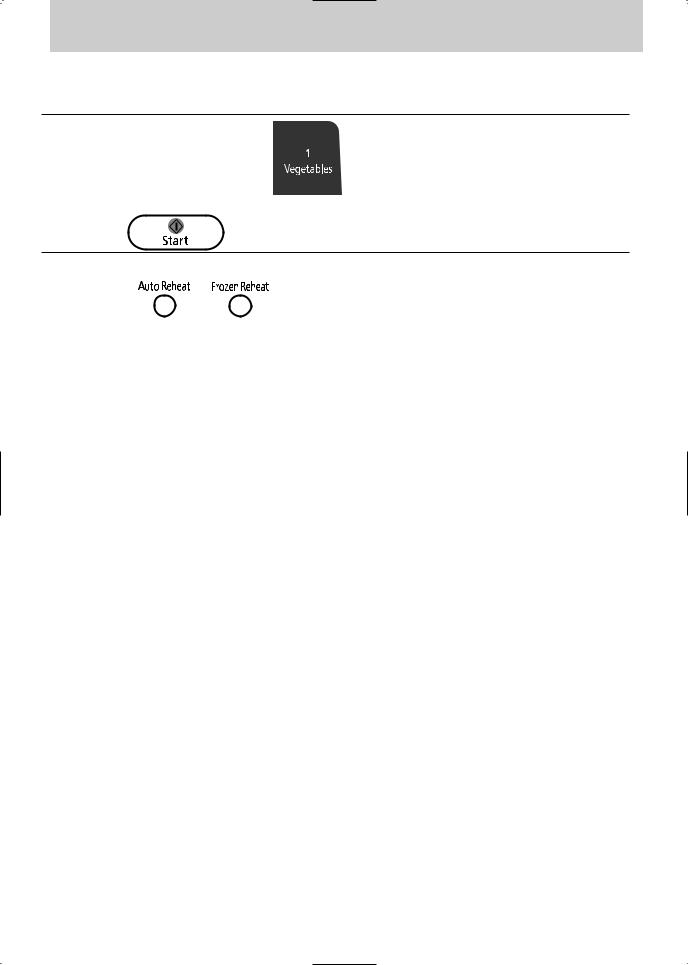
To Cook Food Using Auto Cook Pads
1 Press Desired Food Category Pad until the required food weight/serving size appears in the Display Window (see chart below)
e.g. Vegetables
press once - 120 g is displayed press twice - 180 g
2 Press
Cooking time appears in the Display Window and begins to count down. |
|
||||
To Reheat using |
, |
|
|
|
|
|
|
|
|
|
|
Pad |
|
|
Weight |
|
|
|
|
|
|
|
|
|
1 tap |
2 taps |
3 taps |
4 taps |
|
|
|
||||
|
|
|
|
|
|
Auto Reheat |
|
250 g |
450 g |
650 g |
850 g |
|
|
|
|
|
|
Frozen Reheat |
|
250 g |
450 g |
650 g |
850 g |
|
|
|
|
|
|
To Cook using Auto Cook Pads |
|
|
|
||
|
|
|
|
|
|
Pad |
|
|
Weight |
|
|
|
1 tap |
2 taps |
3 taps |
4 taps |
|
|
|
||||
|
|
|
|
|
|
Vegetables |
|
120 g |
180 g |
250 g |
370 g |
|
|
|
|
|
|
Frozen Veg. |
|
120 g |
250 g |
500 g |
750 g |
|
|
|
|
|
|
Potatoes |
|
250 g |
370 g |
500 g |
900 g |
Pasta |
|
150 g |
250 g |
375 g |
500 g |
Rice |
|
1.0 cup (0.2 kg) |
1.5 cups (0.3 kg) |
2.0 cups (0.4 kg) |
2.5 cups (0.5 kg) |
|
|
|
|
|
|
Noodles |
|
200 g |
350 g |
500 g |
800 g |
Fish |
|
120 g |
250 g |
370 g |
500 g |
Chicken Pcs. |
|
400 g |
600 g |
800 g |
1000 g |
|
|
|
|
|
|
Refer to cookbook chapters for more specific information about Auto Cook categories.
– 13 –
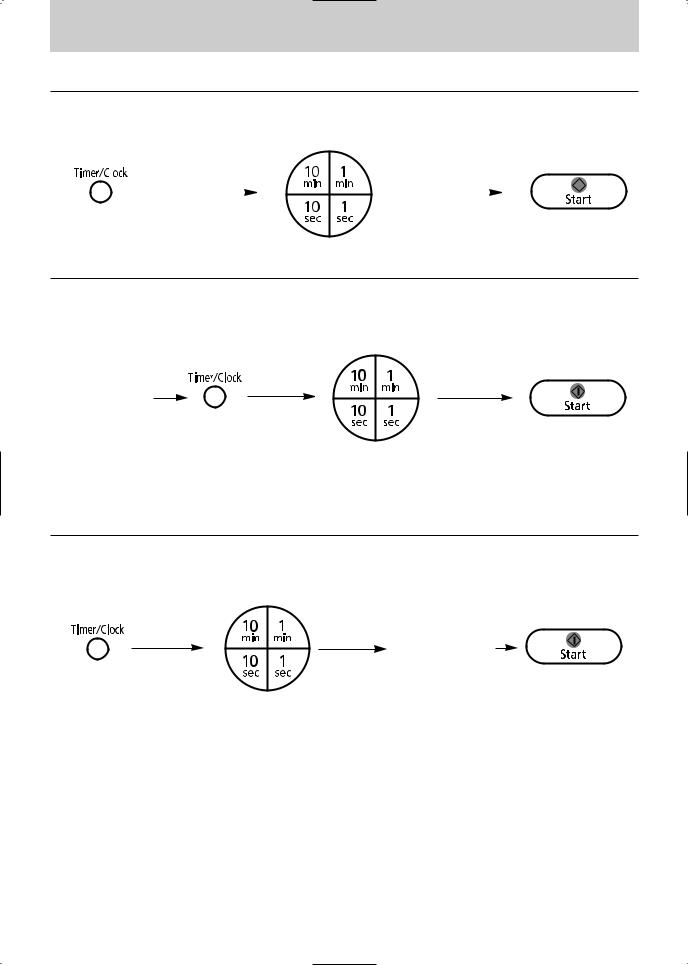
To Use Timer Pad
To Use as a Kitchen Timer
Press once. |
|
Set desired amount of time. |
Press Start. |
|||
|
|
|
(up to 99 minutes and 99 seconds) |
Time will count down |
||
|
|
|
|
|
without oven operating. |
|
|
|
|
|
|
|
|
|
|
|
|
|
|
|
|
|
|
|
|
|
|
|
|
|
|
|
|
|
|
|
|
|
|
|
|
To Set Standing Time
Press once. |
Set desired amount of standing time. |
Press Start. |
|
(up to 99 minutes and 99 seconds) |
Cooking will start. |
|
|
After cooking, standing |
|
|
time will count down |
|
|
without oven operating. |
Set the desired cooking programme.
(see Page 9)
To Set Delay Start
Press once. |
Set desired amount of delay time. |
Press Start. |
|
(up to 99 minutes and 99 seconds) |
Delayed time will count |
|
|
down. Then cooking |
|
|
will start. |
Set the desired cooking programme.
(see Page 9)
NOTES:
1.If oven door is opened during the Standing Time, Delay Start or Kitchen Timer, the time in the Display Window will continue to count down.
2.Delay Start/Standing Time cannot be programmed before/after any Auto Control function. This is to prevent the standing temperature of the food from rising before defrosting or cooking begins. A change in the starting temperature could cause inaccurate results and / or food may deteriorate.
– 14 –

Before Requesting Service
THESE THINGS ARE NORMAL |
|
|
|
The oven causes |
Some radio and TV interference might occur when you cook with the |
interference with my TV. |
microwave oven. This interference is similar to the interference caused by |
|
small appliances such as mixers, vacuums, hair dryers, etc. It does not |
|
indicate a problem with your oven. |
|
|
Steam accumulates |
During cooking, steam and warm air are given off from the food. Most of |
on the oven door and warm |
the steam and warm air are removed from the oven by the air which |
air comes from the oven |
circulates in the oven cavity. However, some steam will condense on |
vents. |
cooler surfaces such as the oven door. This is normal. |
|
|
I accidentally ran my |
Running the oven empty for a short time will not damage the oven. |
microwave oven without |
However, we do not recommend this. |
any food in it. |
|
PROBLEM |
POSSIBLE CAUSE |
REMEDY |
Oven will not turn on.
Oven will not start cooking.
The word "LOCK" appears
The post fan operates after using the oven.
|
The oven is not plugged in |
Remove plug from outlet, wait |
|
securely. |
10 seconds and re-insert. |
|
Circuit breaker or fuse in your home |
Reset external circuit breaker or |
is tripped or blown. |
replace external fuse in your home. |
|
|
There is a problem with the |
Plug another appliance into the |
|
outlet. |
outlet to check if the outlet is working. |
|
The door is not closed completely. |
Close the oven door securely. |
|
Start was not pressed after |
Press Start Pad. |
|
programming. |
|
|
|
|
|
The programme has not been |
Programme again according to the |
|
entered correctly. |
Operating Instructions. |
|
Stop/Reset has been pressed |
Programme over again. |
|
accidentally. |
|
|
The Child Lock was activated |
Deactivated Lock by pressing |
by pressing Start pad 3 times. |
Stop/Reset pad 3 times. |
|
|
The Roller Ring and oven |
Clean these parts according to |
bottom are dirty. |
“Care of Your Microwave Oven” |
|
|
|
(see next page). |
|
The display indicates a problem |
Contact the specified service |
|
with microwave generation |
centre. |
|
system. |
|
|
The fan rotates to cool the electric |
It is quite safe to take out the food |
components. This is normal. |
from the oven while the fan |
|
|
|
operates. |
the oven, contact an authorised Service Centre.
– 15 –
